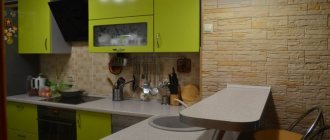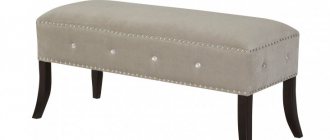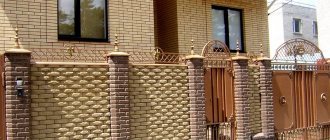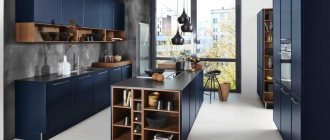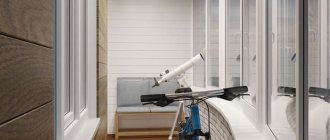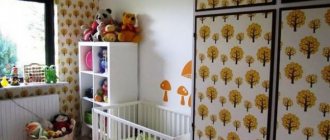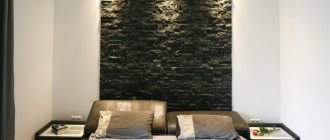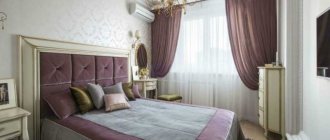A room for storing clothes allows you to save useful space in the house and avoid installing additional furniture. People who are accustomed to comfort and convenience while changing clothes specially equip such rooms in their homes. If living space allows, then separate spaces are created for men and women. Owners of small apartments do not divide this area; they often convert a dressing room from a storage room.
Even a compact room can improve living conditions. Here, all items are in plain sight on open shelves and hangers. This is especially true for those who lead an active lifestyle, because sometimes a person simply does not have time to store and search for things in the closet, so in most cases they end up scattered throughout the house.
Requirements for a dressing room
The storage room can be located near the kitchen or bedroom, in the hallway, or have a different area, it all depends on the size of the apartment and its layout. Before you begin converting a room into a wardrobe, you should find out whether its parameters meet the minimum requirements:
- According to SNiP 2.08.01-89 clause 2.7. the width of the room should be more than 0.8 m, the minimum depth should be at least 1.2 m. Experts recommend 1x1.5 m for this room, respectively. If the space is less than the specified values, then problems will arise during its operation.
- The pantry does not have a window, therefore there is no natural ventilation. Any dressing room simply must be well ventilated. Air exchange should be up to 1.5 times the volume of the entire space. Therefore, here you will have to install a ventilation duct and make a hole in the wall. If this is not done, a musty smell will appear in the room over time, microorganisms, mold, and fungi will appear.
- Good lighting plays an important role. You should not limit yourself to one chandelier; you should provide side lighting and spotlights so that all the contents are clearly visible.
- For 1 m of length when storing things openly, you cannot install more than 7 hangers.
- In the family dressing room, men's and women's clothing are stored separately.
- A small room must be comfortable. It is necessary to rationally use the entire perimeter so that all existing things fit, while leaving free space for movement.
- The design style must correspond to the general one used throughout the house.
DIY storage room conversion
Manual assembly is not only economical, but also practical. The dressing room in the pantry in the Khrushchev building is non-standard, and it is extremely difficult to find an option for yourself. Make it from scratch or buy a ready-made version and remake it.
Drawing up a wardrobe plan
From planning and mathematical calculations, move on to drawing and drawing the project. To avoid wasting a ream of paper, download or select a furniture program. There is no need to redraw or make different plans. But you can try on clothes, different colors and ideas. An example of a program with the possibility of online modeling without installation on a computer is Planoplan.
If a pencil is more to your liking, do whatever is most convenient for you. If you have no experience at all, take an idea from the Internet or download templates for programs. Don't forget to add something of your own. Figure 1 is an example of a drawing.
Follow the clothing sorting criteria. Designate a space for each area, type and size of clothing. Don't make rules into dogma. They are for comfort, and if hats look more accessible at eye level, lower them there.
Do not deviate from the calculated measurements and square footage, take into account the unevenness of the room. Make the distance between the shelves no more than 50 cm, and their depth – 40–60 cm. The exception is shelves with a barbell. Determine their height by the longest item that will hang there, for example, an evening dress. Make the top shelves shallow to make it easier to get and put things down.
Leave 10–15 cm to the top of the cabinet, if there is one. Designate lights, ventilation, mirrors and chairs.
Room decoration
Start by choosing your material. Wood, MDF and metal are suitable for the surfaces of the dressing room. Do not use porous materials - they absorb moisture and odor, and you don’t need dampness. The classic stainless steel bar will suit any design.
Make a dressing room to match the style of the apartment. Do not whitewash the ceiling and walls under any circumstances, otherwise you will regularly get dirty. Make the floor covering from a material that is easy to clean. Linoleum or laminate are suitable, but you should avoid carpets.
The color of the room should distract from its cramped space. Light colors visually expand. Another way to visually enlarge a space is to install mirrors. Use both methods as in the photo
You may be interested in: How to make a dressing room in the bedroom: in the form of a closet, corner and other interesting implementation options
Start the modification in order:
- Clear the room of things and furniture. Throw away the unnecessary ones.
- Remove old finishes from surfaces.
- Provide electricity for lights and ventilation.
- Provide ventilation.
- Lay down the floor.
- Level and finish the walls.
- Assemble and finish shelving.
- Mount the door.
Let's look at the most time-consuming items.
Providing ventilation
A dressing room is a small enclosed space. If it is not ventilated, moths, mold and an unpleasant odor will appear there. The ventilation system must change all the air in the room within 1 hour. The temperature of the pantry should remain within +16–18 degrees Celsius.
Fresh air can be brought in through the standard ventilation shaft of the house, other rooms of the apartment or the street. Standard ventilation schemes:
- The simplest option is a window. If there is one, open it slightly and skip this part of the text. But the storage room is not a balcony, and there are no windows here.
- Transfer grilles in the door and hood in the wall. The hood can lead into a mine or onto the street. A separate question is which direction should the air go? Direct it from the dressing room to the street only if there are no rooms nearby that are sources of bacteria and odors, such as the kitchen or toilet. Otherwise, the air must flow from the street into the house.
- Most often, next to the closet in a panel house there is no external wall or shaft. In this case, you will have to make a hole with a grate into another room. Otherwise, the recycling principle is the same as in paragraph 2.
If you are doing a storage system in a closet along with general renovations, try to ventilate above suspended ceilings. By the way, the transfer grille is replaced by a gap under the door.
Manufacturing and installation of a storage system
Entrust the manufacture of shelves and storage system structures to specialists - buy a ready-made option or order it from a workshop.
If you decide to do everything yourself, then count the amount of materials:
- metal, wood or MFD - the basis of shelves and drawers;
- chrome-plated pipes with a diameter of up to 0.25 cm - for racks and rods;
- edge tape for processing the ends of shelf slabs;
- everything for fastening: screws, hinges, corners;
- handles, hooks.
Next, saw the pipes and shelves to measure, tape the ends, install the mounting frame, and install the storage system. Don't forget about the accessories.
You may be interested in: TOP programs and designers for designing a dressing room online: stages of creation
Be sure to check the ventilation and lighting in the closet before starting installation and installation of the dressing room.
Door installation and decoration
Let's choose between swing doors, accordion doors and compartments.
Swing ones are standard, they are easy to find, select and install. Cons: Needs space to open.
Coupe – many options, less space to open. Disadvantage: the passage is always partially closed.
Swing doors - open the passage and take up less space than swing doors. Disadvantage: more components - higher probability of breakdown.
Doors are made of wood, plastic, chipboard and glass. The choice of material, as well as design, is a matter of style and wallet size. Combine materials, use mirrors, stained glass. The main thing is that the decor looks good against the background of the rest of the apartment.
It is easier to install swing and compartment doors. There are many options for rails and hinges in stores. It is better to install the latter outside so as not to waste space inside the room.
Dressing room design
Let us repeat the important points about successful design in the pantry:
- A narrow dressing room needs light colors and mirrors. They help to abstract from the cramped space.
- Don’t make the dressing room stand out from the rest of the apartment.
- Use angular, U-shaped or linear shelving arrangements. Choose by footage.
- Light emphasizes the main thing, make the main one and additional lamps around the perimeter for beauty and convenience.
- Design based on mathematics. To prevent dresses from crumpling on the bottom and clothes falling out of the closet, first accurately determine the dimensions of the structure, and then make it.
Storage system layout options
Before you start re-equipment, you need to draw up a plan and indicate all the dimensions in it. You should consider the structure of storing things, provide space for large items in advance, determine the number of hangers for outerwear, and choose between a closed niche or open shelves.
The main condition is to make the room convenient for use, while saving as much free space as possible.
Depending on the parameters of the pantry, the configuration of the dressing room is chosen. There are several options for arranging the layout used for the storage system:
- one-sided (linear);
- L-shaped;
- double-sided (parallel);
- three-sided (U-shaped).
Linear arrangement
A common method of equipping a dressing room, which is suitable for small spaces. With a one-sided layout, a room with a width of 1.25 - 1.5 m is sufficient; the length can be any. The shelves are located along one wall and form a spacious closet. If the wall is long enough, then with proper arrangement of things you can allocate space for storing additional equipment, for example, an ironing board, a vacuum cleaner.
You can save space only by using open shelves, and it doesn’t make sense to place a niche in a confined space. A closet can be organized in many ways. This can be a separate wardrobe, a design consisting of hanging shelves with hooks or a crossbar for hangers, floor or wall boxes for storing shoes and clothes.
The optimal width of the dressing room is 1.35 cm; if the rooms are wider than 1.5 m, then it is rational to place a row of shallow-depth shelves on the other side.
Parallel arrangement
With this organization of space, it will be possible to place much more things than in the previous version. The layout is optimal for the whole family. One side can be made male, the other female. This will allow each resident to get ready much faster. If, when placing shelves linearly, experts recommend that the doors open inward, then for a double-sided arrangement it is better to provide an external method.
It will be possible to implement the plan only if the width of the room is at least 1.75 m. The distance is calculated taking into account storage areas of 60 cm from both walls, as well as free passage, which should be more than 0.55 m. If it is not possible to expand the room, then this method of storing things is not suitable for small storage rooms located in most apartments.
L-shaped/corner arrangement
This method is used when it is impossible to organize parallel planning. Along with linear placement, the option will be optimal for Khrushchev, while the width of the closet should also be 1.25-1.5 m. This arrangement is more functional, unlike one-sided, since two walls are used.
The dressing room can be easily divided into two zones used by different-sex family members. Doors can open both inward and outward. For a more comfortable, efficient use of space, it is worth considering the option of installing a corner cabinet. In the problem area, which is the corner, it is better to store rarely used items.
U-shaped arrangement
The most practical way to organize space is when 3 free surfaces are involved. The length of the room should be at least 1.6 - 1.8 m, and its width 1.75 - 2 m. The largest number of things can be placed in the dressing room. However, just like with the parallel method of storing things, redevelopment requires a fairly spacious room.
Along the perpendicular partition, in relation to the remaining walls involved, it is better to place a crossbar for hangers instead of shelves. This is due to the fact that it is easier to get clothes placed on hangers than to try to find something in the corner. Large items can be stored in problem areas.
How to make a dressing room in a pantry
Dedicating a room for clothes is not a whim, but a practical necessity. To ensure your walk-in closet doesn't disappoint, start with planning and keep a few important rules in mind so you don't have to redo it later. Take the task seriously, and you won’t have to pay twice – with your wallet and your nerves.
Planning principles
Task No. 1 – decide what and where you will store. Decide "on shore" what will be stored in the new room. Don't miss anything - underwear, clothes, jackets, accessories, trinkets...
Let's break down all things according to three criteria - how, whose and where:
- How will they be stored - on hangers, on a shelf or in special conditions (shoes, hats, accessories)? Measure the largest piece of each type as it will be in the dressing room. For example, for a jacket, measure the shoulder span and length, for a T-shirt, measure the folded width and length.
- Whose things are men's, women's or children's? Zoning will give a feeling of order and convenience. Think ahead. It is better for one person to store things in two zones than for two people in one zone after a year.
- Where is the best place to store it? Store everyday clothes no higher than your height, hats at arm's length, and shoes at the bottom. Hard-to-reach shelves are suitable for long-term storage.
Task No. 2 – you need to determine the area and height of the room.
Task No. 3 – choose the shape of the dressing room. Three types of wardrobes are suitable for the pantry:
- U-shaped - shelves are located along three walls, there is free space in the middle;
- linear - when there is not enough space, a closet is built in the pantry;
- corner - place the racks on both sides if there is more space than for a linear one, but not enough for a U-shaped view.
Once everything has been determined and calculated, you will understand two things - how much space is needed and whether what you want to fit will fit.
List of basic requirements
You can't make a dressing room from just any closet. It must meet the basic requirements:
- Quadrature – more than 1.5. Otherwise it will be cramped, uncomfortable and nothing will fit there. If the shelves will be in a U-shape or at an angle, make sure that you will fit in the dressing room with them.
- Constant ventilation. Stuffiness is dangerous for delicate items and contributes to unpleasant odors. If the builders did not provide for ventilation, you should provide it. Choose between passive supply and active ventilation systems.
- Lighting. As a rule, there are no windows in the pantry. Even if they are there, windows are useless at night. Consider artificial light.
You may be interested in: Mini dressing room 2 sq. m: space planning and design
If you choose active ventilation, make sure that the fan noise does not disturb you.
Types of wardrobe storage systems
The functionality of the wardrobe depends on the organization of the storage structure. It consists of a large number of parts of different directions, the parameters of which are selected individually. Wardrobe systems differ in the material of manufacture, the number of elements, and installation method.
Among the existing types that can be equipped in a former storeroom, the following complexes can be distinguished:
- case;
- frame;
- mesh.
Hull
This arrangement is classic. The designs are in great demand. However, for small non-standard rooms you will have to make custom-made furniture. For its production, natural wood, MDF, and chipboard are used. These materials give the complex an elegant look, they are easy to clean and do not require constant maintenance.
The products are distinguished by their stationary installation method, fairly heavy weight, as they have side walls, a bottom, and a ceiling. The structures are installed along the wall, the individual modules are connected to each other with ties. The advantages of housing systems include:
- the presence of open and closed elements;
- a large assortment of different shades;
- good capacity;
- easy care;
- low cost.
The disadvantages of the storage system include stationary installation, the inability to change assembly parameters, with the exception of the position of some shelves, and difficult installation to do it yourself.
Mesh
The mesh system resembles a honeycomb in appearance and includes various baskets and shelves. Allows you to place everyday items, shoes, hats. The design is very convenient, applicable for any non-standard premises, especially those where it is not possible to install massive products made of wood and its derivatives.
The mesh wardrobe is equipped with shoe racks, rods for placement, and shelves. It is made mainly of metal, but there are also more expensive wooden models. The structure has a rather unusual appearance and will complement any modern style. Among the main advantages are:
- good air circulation, things do not acquire a musty smell;
- the material is easy to clean;
- is characterized by low weight and high strength;
- there is the possibility of transformation;
- all things are in plain sight, making them easier to find;
- has a breathable structure;
- takes up minimal space;
- The installation is easy to do yourself.
Disadvantages include the high cost of the product and incompatibility with components from other manufacturers. Clothes may fall from level racks if they are accidentally touched.
Frame
The main feature of the system is the presence of metal racks to which shelves, drawers, rods, and other functional elements are attached. Typically, columns are fixed at their different ends to the floor and ceiling. The design has no side or rear walls, allowing you to use the entire space right up to the ceiling. The layout is suitable for classic styles, be it modern or high-tech. The main advantages of such a dressing room include:
- strength;
- simple installation and dismantling;
- good combination of wood and metal;
- absence of walls and partitions;
- easy care and maintenance;
- the ability to change the location of internal elements;
- allows use of an area from floor to ceiling.
The disadvantages of the design include its rather high cost. Open shelves are unacceptable for some people, as even minor clutter will immediately catch the eye.
Planning zones in the dressing room
The effectiveness of any dressing room depends on the correct distribution of space. Typically, pantries are not large in size, so ergonomics come to the fore when arranging them. Zoning in a room with small dimensions should be carefully thought out. There should be enough space for all-season clothing, massive winter shoes, bed linen and other things.
When designing shelves, cabinets, stands, it is necessary to provide for sections of different sizes and depths, with enough space to accommodate hangers. The wardrobe space is divided into three zones according to the standard.
Upper zone
This is the place for mezzanines. The upper zone is considered to be a space located at a height of at least 190 cm from the floor. This is a hard-to-reach place, so it is better to place things here that are rarely used. The less often an item of clothing or a suitcase is taken out, the further it should be pushed. The exception is the pantograph. A modern hanger is convenient to use at any height.
Just below the mezzanines there are shelves for hats, scarves, and shawls. Small items will not take up much space, so narrow but wide drawers are sufficient. They should be at arm's length.
Before building shelves into the dressing room, you need to decide on the size of the stored items. The cells must be ideal in depth and width. It is better to make them 2-3 cm taller than suitcases, shoe boxes, and mattresses. When drawing up a project for a small room from a former storage room, it is necessary to provide enough space in the center for the free movement of a ladder or step-chair.
Middle zone
According to the drawing, the middle zone is placed at a height of 60-190 cm. The most advantageous location for frequently used items. Any item can be reached by hand, practically from one point in the center of a small dressing room.
The main part of the space in the middle zone is filled with rods for storing clothes in a straightened form. Items on hangers may hang down into the lower zone, but they must be removed without bending over. If the depth of the former storage room allows, the rods are placed perpendicular to the wall, if not, parallel.
Drawers and shelves should be at eye level. An interesting solution is wicker baskets, metal mesh, transparent containers for laundry. This way the clothes are well ventilated and will be easy to see. Open shelves are ideal for storing T-shirts, sportswear, jeans, sweaters and other casual wardrobes.
Lower zone
The space is designed to accommodate shoes. In a small room, it is better to store shoes and boots in special modules, filling them according to the season. Models that will not be used in the near future should be sent to the upper zone.
Shelves for casual shoes should be placed 30-40 cm from the floor. They can be made straight or at an angle of 45 degrees, ensuring good viewing. To save space, they equip the room with compact structures - retractable sections, roof rails with horizontal opening.
Above the shoe rack, it is rational to place open shelves for storing bags, belts, and gloves. Drawers for bed linen are also placed here. The cells can be placed along one wall or along the perimeter of the dressing room.
The main aspects of dressing rooms
When starting to arrange a dressing room in the pantry, they think through all the main aspects. First of all, the number of stored items is assessed and they are divided into categories. The method of their storage is also determined. For example, for large items you need upper shelves, for outerwear - rods with hangers, for linen - drawers.
Configuration Types
How to distribute space in the dressing room? This directly depends on the shape of the pantry. There are several storage system design options. Here are some examples:
- Linear storage system. You can arrange shelving along one wall of the pantry, which differs little in design from a regular cabinet. With this layout model, you need to think carefully about the number of rods, shelves, and drawers.
- The storage system is arranged in an L-shape. For Khrushchev this is the best option. Ideal for rooms with a long rectangular shape. In addition to things, you can store a vacuum cleaner, ironing board, etc. in them.
- U-shape configuration. It is the most practical and spacious. In this case, 100% utilization of space is ensured.
- Corner option. Quite non-standard, but it allows you to correct problem areas of the room, getting a spacious storage room.
Modern storage systems
The functionality of a dressing room is determined by a properly designed storage system. It is necessary to choose it based on the area of the room. There are only three types of wardrobe systems; let’s look at their main advantages and design features.
Article on the topic: Arranging a dressing room in the hallway: simple options and original solutions
Hull
To manufacture cabinet furniture, you need exact dimensions, a developed project and a craftsman who will do everything to order. The advantages include functional placement of stored items, impressive volumes and reliable design. But, despite all the advantages, there are also disadvantages: firstly, shelves and drawers are bulky and take up a lot of usable space, and secondly, it is impossible to change the layout of the furniture.
Mesh
The mesh (honeycomb) type design is versatile and compact. It consists of lightweight shelving, the shelves have a mesh base, the same type of baskets are attached to hooks and brackets. This system is easy to install - installing such a dressing room in a closet with your own hands is not difficult. In addition, it is possible to change the configuration of the dressing room at any time.
Important! If a mesh type of construction is chosen for a dressing room in a pantry, take into account the fact that the storage system is not capable of supporting heavy items.
Frame
The frame-type design involves the installation of metal racks that are attached to the floor and ceiling. Racks and shelves are arranged on the crossbars. You can also attach rods for outerwear. The drawers are quite easy to install. The advantages of this design include ease of installation and the ability to change the project at any time. Visually, such a system looks light, this is ensured by the absence of side elements.
Breakdown into zones
The disadvantage of the functioning of a dressing room in apartments with an old layout is its small dimensions. To optimize this problem, carefully consider the planning of storage areas.
According to the standard, the wardrobe space is divided into three main zones:
- Bottom. Boxes with shoes, umbrellas and other accessories are usually located here. The lower space occupies about 0.8 m from the floor. The height of the shelves for storing shoes in summer is 0.25 m, and in winter – 0.45 m.
- Average. Usually intended for things of permanent use. There is also space for outerwear here. The height of the zone should range from 1.5 to 1.7 m. In a certain place, the space should be further divided for placing shirts, trousers, and skirts.
- Upper. Basically they are racks and are intended for arranging seasonal items. You can also place bed linen, blankets, pillows, suitcases, etc. The optimal height of the upper shelves is 0.2 m, and the depth is at least 0.25 m.
Proper division of the dressing room into zones will allow you to use this room comfortably
Convenient storage devices
The modern furniture market is filled with a large number of devices designed for compact and convenient arrangement of things:
- Devices for hanging trousers and skirts, which have special rubberized clips. This allows you to avoid leaving traces of bending, as with conventional hangers.
- Hangers that have not one, but several crossbars will help you place several identical things, which will make the most of the space.
- You should also take a closer look at systems for convenient placement of ties, belts, belts, scarves, etc.
- Instead of a conventional crossbar, you can use a new idea - a pantograph elevator. It can be lowered down using the adjustment lever.
- Various modules for shoes are very convenient to use. These can be platforms with special protrusions on which shoes are placed.
Finishing and lighting device
A dressing room in a closet is an enclosed space. Therefore, the next aspect that needs to be discussed in more detail when remodeling is lighting. In this direction, small spotlights or wall lamps with a device for free rotation in the desired direction are used.
Related article: Which wardrobe to choose: types and design features
You can think about lighting for clothes. In this case, mini LED bulbs attached to crossbars or other elements would be a good option. They should not be located too close to the shelves and cling to clothes.
It would be good if there was internal lighting for the drawers. This can be done using LED strips.
A separate discussion is wall decoration. There are several rules here: the surface must be smooth, painted or covered with both light colors. You can arrange a mirror surface or soft drapery in some areas.
Advice! Light colors and mirror surfaces can visually expand the space. We try to follow this simple rule.
Decoration of the door department
Having finished with the zoning and storage system, they move on to arranging the doorway. This is not an unimportant aspect, since it also carries a design burden.
Let's imagine several options for closing the doorway of the dressing room in the pantry:
- The easiest and most affordable way to remodel is to leave the opening open. Some shelves are moved outside the pantry. This option is suitable only for the hallway.
- Screens are often used to divide space and sliding door options. The design of the sliding system is ordered in workshops, having previously chosen the decor to suit your taste.
- In the case of a conventional screen, you should make it stylish and creative. Select appropriate textiles and cornices that will be in complete harmony with the interior of the room.
Finishing methods and options
You can remodel a room for storing clothes and shoes using a variety of materials. A dressing room consisting of a small pantry with access to the corridor will be used mainly for storing outerwear, so the wall covering should be practical and moisture-resistant. The floor should be made of tiles or thick linoleum, since in the fall it will often be wet from shoes after rain; in winter, boots will apply sand to it after running along sprinkled sidewalks and steps. If you can refurbish a spacious room, surface repairs begin from top to bottom:
- Ceiling. The most open surface in the dressing room must be light and expressive. For finishing, colored putty, paint, whitewash, wallpaper, hanging, tension structures, and plastic panels are often used. There are no serious requirements for materials if the room is ventilated and well lit.
- Walls. For side walls, it is better to choose practical, non-staining finishing materials. Paint, plastic lining, washable wallpaper are suitable. It is better not to use dense panels, as they will take away precious square meters for the former pantry. If the size of the room does not resemble a storage room in a Khrushchev-era building, you can decorate the walls with wood or plasterboard.
- Floor. The flooring in the dressing room will be subject to serious stress. This should be taken into account when choosing materials for its design. A large number of clothes collected together means there is no dust generation. For the floor you can use linoleum, tiles, laminate, wood.
Stylistic and color design
You can create an expressive room from a simple pantry if you properly design the surfaces and make good accents on the contents. A certain style is set not only by shelving structures, but also by their color, location features, and design. You can decorate the room in accordance with the following stylistic directions:
- Classic. Full-fledged facades and sliding wardrobes would be appropriate. The finish should be clear, without unnecessary details. The walls are plain, painted or wallpapered in pastel colors, the floor is made of natural materials (stone, wood). Furniture is only necessary and functional, for example, a table, a small ottoman.
- Eco style. The most peaceful design should not be overloaded with useless details. Only natural materials are used for finishing surfaces and as furniture materials.
- Minimalism. No accessories or decor. Only open strict shelves. Color: white-black, beige, brown.
- Techno. Cool, thoughtful style. The dressing room has only straight lines, many drawers with fancy fittings, and metal spotlights. Rough materials are used for finishing: metal, glass.
- High tech. Suitable for spacious walk-in closets. Advanced technologies and the latest materials are used to furnish the rooms. Lots of glass, plastic, metal. The colors mainly present are grey, metallic and white.
- Fusion Allows you to connect several directions at once. You can combine angular shelving and a fabric lampshade, plastic furniture and wooden flooring. A combination of a bright textile screen and a shabby chic dressing table would be appropriate.
Lighting and ventilation
The former storerooms of apartment buildings do not have windows, so when drawing up a dressing room design, you should consider the correct location of lamps and ventilation holes. During operation, a specific room will always be saturated with skin particles and dust.
If the room borders the street, you can create natural ventilation by making small valves near the floor and under the ceiling, which will ensure the supply of fresh air and the outflow of exhaust air. This method can also be used when ventilation ducts are located close together. To increase the air exchange rate, fans are installed. The influx of oxygen is ensured naturally, and the removal through forced exhaust. The size of the holes and the speed of movement of air masses are calculated based on the size of the dressing room.
Any dressing room requires a large number of clothes and shoes placed in their place. You can quickly find the necessary clothes and evaluate the right combination of colors only in bright light. It would be better if it was multi-zone lighting. Several lamps are placed on the ceiling, a rotating lampshade near the mirror, and LED strips above a bar with hangers.
Doorway design
Converting a closet into a dressing room will forever change the attitude towards simple storage of supplies, if you design the doorway correctly. The room can be left open or closed with a stylish screen, massive door, or sliding structures. You can use mirrors, glass, plastic inserts, and textile elements as decoration.
Hinged doors are suitable for spacious rooms. The canvas can be improved by attaching narrow shelves to the inside. Small rooms will be decorated with curtains and accordion doors hung on the cornice. This is the simplest and most budget option.
Arrangement details
A dressing room in a Khrushchev-era building begins with clearing the area of unnecessary things. If things are stored in the pantry, they should be sorted out and only the truly necessary ones should be left. Agree, there is no point in storing one ski or one boot in the hope of someday finding a pair to match these elements. It is better to clear spaces for other, more necessary and important items in everyday life.
The dressing room from the pantry in the Khrushchev building is converted in several stages. After removing all contents, it is necessary to refresh the surfaces. It is recommended to finish the floor with tiles and paint the walls with silicone paint. A small cosmetic renovation will freshen up the room and prevent fungus from occurring. In order for the pantry to be transformed into a dressing room, you must hang a large mirror, the height of a person, on the door. This is a mandatory attribute that allows you to put yourself in order without leaving the racks of clothes.
